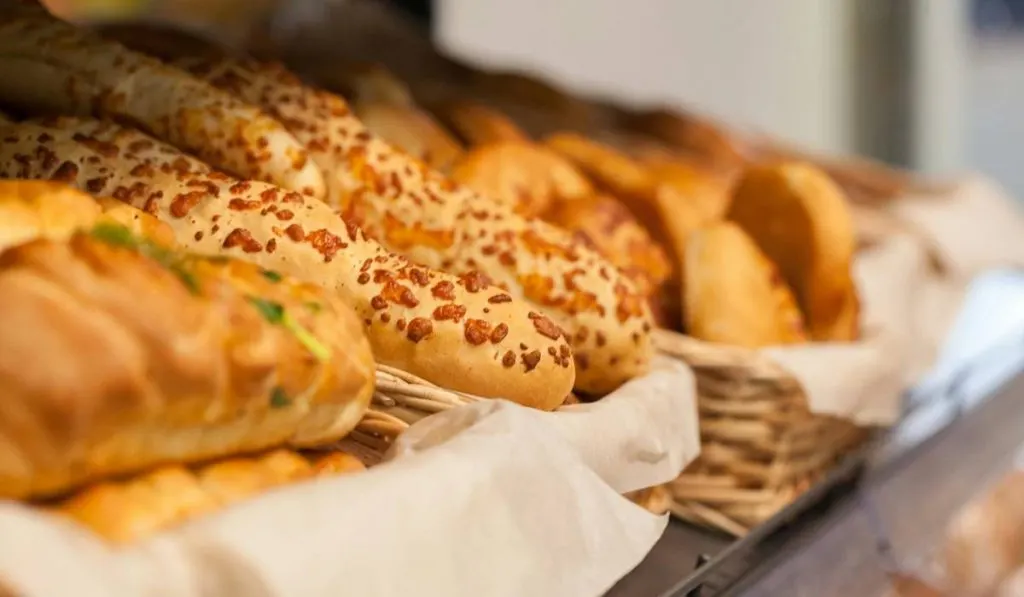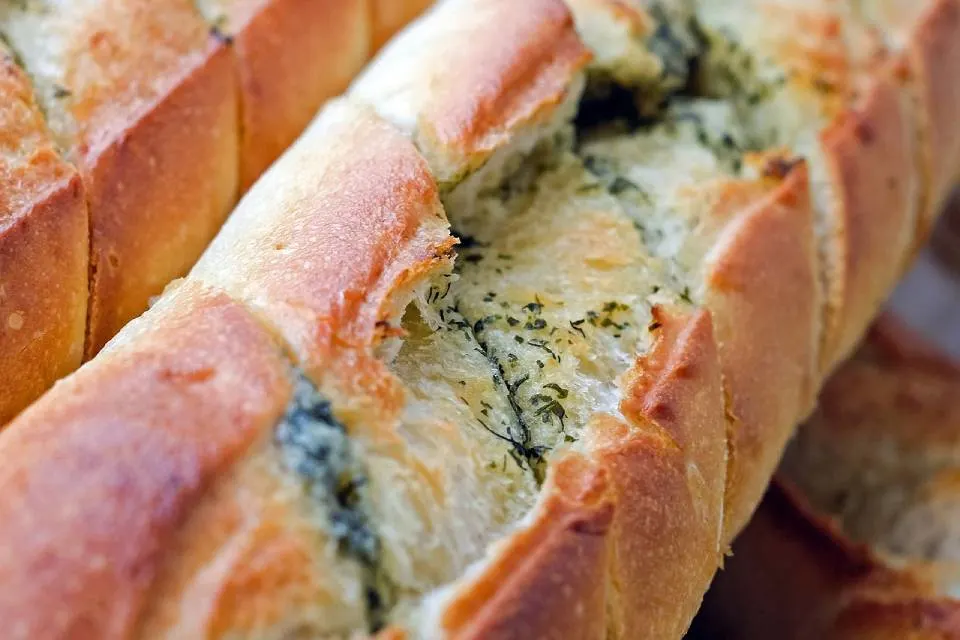
Imagine the aroma of freshly baked bread wafting through your kitchen, intertwined with the fragrant scents of rosemary, thyme, and garlic, all crowned with the irresistible allure of melted cheese. This isn’t just any bread; it’s Italian Herb and Cheese Bread, a staple that transforms a simple meal into a comforting feast.
TL;DR: Key Takeaways
- Italian Herb and Cheese Bread is a beloved favorite, enjoyed by 31% of Americans weekly.
- It’s not just delicious but steeped in tradition, often featuring in family recipes passed down through generations.
- This bread is a versatile star in kitchens, pairing wonderfully with a variety of dishes.
- Making it at home allows for customization to suit your taste preferences.
- Subway has popularized this bread, but homemade versions offer a personalized touch.
The Irresistible Appeal of Italian Herb and Cheese Bread
A Staple in American Kitchens
The love affair America has with Italian Herb and Cheese Bread is more than just a passing trend. According to a 2020 survey by Statista, a significant 31% of Americans savor Italian breads, including the herb and cheese variant, at least once every week. This statistic isn’t just a number; it’s a testament to the bread’s entrenched position in the American culinary landscape. From bustling city delis to quiet suburban kitchens, this bread has become a cornerstone of comfort food, blending the rustic charm of Italian cuisine with the diverse tastes of America. Its versatility is unmatched, serving as the perfect companion to a steaming bowl of soup, a hearty salad, or simply enjoyed on its own, basking in its herby, cheesy glory.
A Subway Favorite
Subway, the global sandwich giant, has been instrumental in catapulting Italian Herb and Cheese Bread from a bakery specialty to a mainstream favorite. This bread, characterized by its golden crust infused with a medley of herbs and topped with a generous layer of melted cheese, has become synonymous with Subway’s identity. It’s the go-to choice for many, elevating a simple sandwich to something extraordinary. The secret lies in the harmonious blend of flavors – the bread acts as a canvas, bringing together the boldness of garlic, the warmth of rosemary, and the earthiness of thyme, all complemented by the sharpness of Parmesan and the smooth melt of Monterey cheddar. This combination has not only won over taste buds but also set a benchmark for what sandwich bread can aspire to be.
Rooted in Tradition
Celebrity chef Mario Batali once captured the essence of Italian cooking with his words, “The best recipe you can use is always based on what your mother made you.” This rings profoundly true for Italian Herb and Cheese Bread, which for many, is not just food but a slice of heritage. In countless Italian families, recipes for this bread are cherished heirlooms, passed down through generations. Each loaf is a narrative, woven with stories of old-world kitchens, Sunday family dinners, and the hands of ancestors who kneaded love and tradition into every batch. This bread is more than just ingredients mixed together; it’s a celebration of family, history, and the simple joys of sharing a meal made with care. In every bite, there’s a sense of connection to the past, a nod to the simplicity of good food made from the heart.
Crafting the Perfect Loaf: A Guide to Herbs and Cheeses
Selecting the Ideal Herbs and Cheeses
The secret to an exquisite loaf lies in the harmonious blend of herbs and cheeses you choose. This bread thrives on customization, allowing you to tailor its flavor profile to your liking. Classic herb choices such as rosemary and thyme offer a fragrant, earthy base, while the addition of minced garlic can introduce a subtle, piquant kick that elevates the overall taste.
For those looking to venture beyond the traditional, consider incorporating basil for its sweet, peppery essence, oregano for a touch of boldness, or even a sprinkle of sage for its slightly peppery flavor with hints of mint. Each herb brings its own unique character to the bread, creating a complex bouquet of flavors that can transform a simple loaf into a culinary masterpiece.
When it comes to infusing your bread with cheese, the possibilities are just as enticing. Parmesan, with its nutty and slightly fruity undertones, and Monterey cheddar, known for its perfect melt and mild sharpness, serve as excellent foundations. However, exploring other cheese varieties can introduce new dimensions of flavor. Mozzarella, with its creamy texture and delicate taste, can add a wonderful gooeyness to your bread, while Asiago, a cheese with a more robust flavor profile, can impart a slightly tangy and nutty essence, enriching the bread’s overall flavor.
Mastering the Art of Perfect Pairings
This herb and cheese-infused bread is a versatile masterpiece that seamlessly adapts to a wide array of culinary settings. Its robust flavor profile makes it an ideal companion to hearty soups, providing a comforting, savory counterpoint. When paired with refined salads, the bread’s rich taste and aromatic herbs can enhance the fresh, crisp ingredients, creating a delightful contrast.
Moreover, this bread serves as an impeccable foundation for gourmet open-faced sandwiches. Imagine a slice of this aromatic loaf, lightly toasted to perfection, then topped with ripe, juicy tomatoes, a sprinkle of fresh basil, and a final drizzle of balsamic glaze. The acidity of the tomatoes and the sweet, tangy reduction of the balsamic glaze marry beautifully with the savory depth of the bread, crafting an eating experience that is both sophisticated and immensely satisfying.
Insider Tips for the Ultimate Loaf
To achieve the ultimate loaf of Italian Herb and Cheese Bread, delving into the nuances of baking can make all the difference. Here are some expanded insights to guide you through the process:
Achieving the Ideal Dough Texture
The journey to a perfect loaf begins with mastering the dough’s texture. Aim for a consistency that’s soft to the touch and slightly tacky, but not overly wet or sticky. This balance ensures the dough is moist enough for the yeast to thrive while retaining enough structure for gluten development. Gluten, the protein network within your dough, is what gives bread its elasticity and chew. To develop this properly, knead your dough with purpose and patience. Use the heel of your hand to push the dough away from you, then fold it back over itself, turning it a quarter turn each time. This process might take 10 to 15 minutes by hand. You’ll know you’ve kneaded enough when the dough becomes smooth, elastic, and passes the “windowpane test”: a small piece stretched between your fingers should form a thin, translucent membrane without tearing.

Letting the Flavors Marry
The art of bread-making is as much about flavor as it is about texture. After kneading, the dough must undergo a first rise, or ‘bulk fermentation,’ which is pivotal not just for the dough to double in size but also for flavor development. During this time, the yeast ferments the dough’s sugars, releasing carbon dioxide and alcohol, which contribute to the bread’s flavor and aroma. This process allows the herbs and cheese within the dough to infuse their flavors deeply, creating a more nuanced and harmonious taste profile. Ensure your dough rests in a warm, draft-free spot, covered lightly with a damp cloth or plastic wrap to prevent drying. This rise can take 1 to 2 hours, depending on your kitchen’s temperature.
Infusing Your Loaf with a Personal Touch
Italian Herb and Cheese Bread is a canvas for culinary creativity, allowing you to infuse each loaf with personal touches that reflect your taste preferences and imagination. Consider the addition of chili flakes to introduce a subtle heat that cuts through the richness of the cheese, or a drizzle of honey to balance the savory notes with a hint of sweetness. For a Mediterranean twist, incorporate a handful of chopped olives or sun-dried tomatoes into the dough for a briny depth. These ingredients not only add complexity to the flavor profile but also create a beautiful mosaic within the bread when sliced.
When experimenting with additions, consider the moisture content they may add to the dough and adjust your hydration levels accordingly. For instance, olives and sun-dried tomatoes should be well-drained and patted dry to avoid making the dough too wet.
Conclusion
Italian Herb and Cheese Bread transcends the ordinary, offering a rich tapestry of flavors and a nod to culinary heritage. It’s a celebration of tradition and personal touch, inviting both experienced bakers and newcomers to explore the artistry of bread-making. This bread isn’t merely an accompaniment but a centerpiece that brings warmth and connection to any table. Embarking on the journey to perfect it promises not just a delicious outcome but a rewarding experience of creation and sharing. Each loaf, infused with love and care, becomes a testament to the timeless joy of baking and the simple pleasure of enjoying good food with those we cherish.
FAQs
Q: Can I use dried herbs instead of fresh?
A: Absolutely! While fresh herbs offer a vibrant flavor, dried herbs are a convenient and equally tasty alternative. Just remember, dried herbs are more potent, so use them sparingly.
Q: How can I store leftover bread?
A: Wrap the bread tightly in plastic wrap or store it in an airtight container. It can last for up to 3 days at room temperature or can be frozen for longer storage.
Q: Can this bread be made vegan?
A: Yes, by substituting the cheese with vegan alternatives and ensuring the bread base meets vegan standards, you can easily adapt this recipe for a vegan diet.
Q: Is Italian Herb and Cheese Bread suitable for beginners?
A: Definitely! While it might seem complex, the process is quite straightforward. With a little patience and practice, anyone can create a delicious loaf.
Q: Can I add meats or other fillings to the bread?
A: Incorporating additional fillings like cooked sausage, pepperoni, or even caramelized onions can turn this bread into a hearty meal on its own. Just ensure any added ingredients are fully cooked before incorporating them into the dough.
Q: Can I use whole wheat flour for this recipe?
A: Yes, you can use whole wheat flour to make this bread, but keep in mind that whole wheat flour absorbs more liquid than all-purpose or bread flour, so you might need to adjust the hydration of your dough. Whole wheat will also make the bread denser and heartier. For a lighter texture, consider using a mix of whole wheat and white flour.
Q: How can I achieve a crispy crust on my bread?
A: To achieve a crispy crust, you can create steam in your oven during the first few minutes of baking. Place a shallow pan on the bottom rack of the oven and add boiling water to it just before placing your bread in the oven. The steam will help create a crispy crust. Additionally, brushing the top of your dough with water or a light egg wash before baking can also contribute to a crispier crust.
Join Us and Transform >
Don’t Be an Amateur! Master the Art of Sourdough Bread!




Sandra, your post hit home! Your mention of Alsace stirred up memories of past wine tours I’ve enjoyed there. How do you think the region’s microclimate contributes to their unique Gewürztraminer? Also, have you ever tried pairing it with spicy Thai food? I’ve found it to be a delightful combo that others might want to try too! By the way, I totally agree about the underappreciated charm of an off-dry Riesling. Keep up the good work, Sandra! 🍷👏